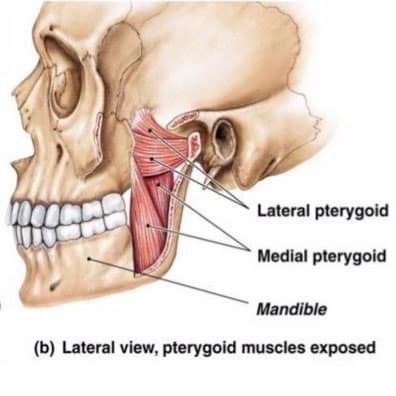I have a list of favourite muscles, and this one is top of my list along with the adductor magnus and obturator internus.
I am hoping I am not the only one with a hierarchy of favourite muscles. I would love to know what other peoples are?
In my very first dissection I decided the pterygoids would be my project, nothing like throwing yourself in on your first go and I have to say they didn’t disappoint.
We have two pterygoid muscles- medial and lateral pterygoids; lateral is subdivided into two as it has a superior and inferior head. The medial and lateral pterygoids are muscles of mastication.
Pterygoid means wing-shaped and both of these muscles attach to different places on the sphenoid bone.
The medial pterygoid
Correct terminology: It attaches onto the medial surface of the lateral pterygoid plate of the pterygoid process of the sphenoid.
Easy version: This is quite a mouthful, in more straightforward terms the sphenoid bone has a bony process that has lateral and medial feet for want of a better word coming off of it, these are called pterygoid plates. The medial pterygoid attaches onto the medial side of the lateral plate.

-Attaching onto the internal surface of the mandible
The insertion of the medial pterygoid joins the masseter. The medial pterygoid pretty much mirrors the masseter but on the inside of the mandible. Together these two muscles form a sling that elevates the jaw.
The medial pterygoid elevates the mandible and contralaterally deviates the mandible, meaning it pulls the mandible towards the opposite side of the body, important for chewing.
The lateral pterygoid- Superior & Inferior Head
The inferior head attaches from the lateral side of the same process as the medial pterygoid attaches to onto the neck of the mandible.
The superior head attaches from the greater wing of the sphenoid to the capsule and disc of the temporomandibular joint.
The lateral pterygoid protracts the mandible, helping in opening the jaw, unlike the other 3 muscle of mastication that closes the jaw. It also creates contralateral deviation of the mandible- moving the jaw towards the opposite side.
The superior head helps draws the disc forward along with the mandible. So that the disc and mandible move together when the jaw is opened.
Isn’t that exciting that these two heads have to work together to allow the disc and mandible to draw forward for efficient movement.
Dysfunction or imbalance can cause the disc and mandible to track out of sync, and the disc can become displaced, this can cause inflammation, pain and be accompanied by clicking.
Temporomandibular joint syndrome/ dysfunction is an article all to itself.

